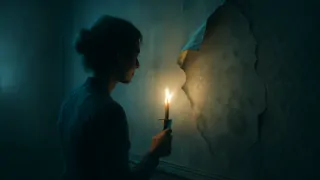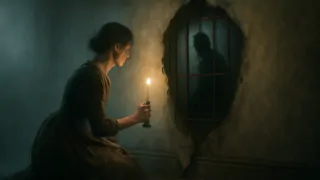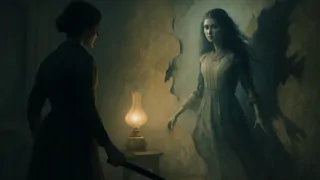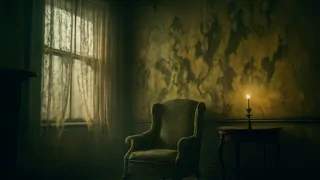Introduction
Late in the autumn of 1898, Eleanor Fairchild arrived at the secluded Morton House, nestled among Pennsylvania’s rolling foothills. The grand Victorian turrets rose behind a veil of mist, and the winding gravel drive seemed to vanish into walls of ancient oak. Eleanor, delicate in both body and spirit, stepped from the carriage with a flutter of dread, her husband Henry by her side, offering reassurances that barely countered the house’s hush. Once inside, a narrow hallway led to an ante-room whose walls were sheathed in sickly yellow paper, its intricate floral motifs curling and fading as though retreating from the world. Where the paper peeled at the corners, dark smudges clung like fingerprints, and the lamplight cast jittering shadows across the pattern. A stale sweetness lingered in the air, a perfume of old plaster and wilted roses. Eleanor’s breath caught at a single motif—a cluster of twisted vines that seemed to twist further as she watched, as though alive. Later, Henry guided her to a small attic chamber draped in lace curtains and crowned by sloping rafters. There too, yellow wallpaper clung stubbornly, bold with tangled lilies and thorny vines. As dusk fell, smoldering embers of sunset filtered through the curtains, igniting the paper in dull gold. That night, Eleanor lay awake in the narrow iron bed, eyes tracing the endless pattern until her vision swam. Whispers curled on the edges of her hearing, tiny echoes pressing against the plaster. She dreamed of faces trapped behind the peeling paper, mouths moving without sound, imploring release. Even in the quietest hour, the faintest creak spoke volumes—floorboards sighing as though the house read her thoughts. Eleanor felt the wallpaper’s color shift in the gloom, darkening to ochre and brown, pulsating with secret life. Within these walls, she realized, every layer of paint and paper bore witness to sorrow and confinement, a silent chorus urging her to peel back the veneer and face what lurked beneath. Thus began her fragile journey into the shadows behind the yellow wallpaper, where reality and illusion entwined in a dance as old as the house itself.
The Arrival and First Whispers
Eleanor’s first nights in the Morton House were heavy with silence and half-heard murmurs. Each morning she woke to the same yawning room, its yellow walls glowing faintly under the feeble oil lamp her husband insisted she keep alight. The wallpaper’s pattern struck her with fresh intensity each dawn: a lattice of lilies curling through thorny vines, their edges frayed like laces left out in a storm. In the few hours of daylight, a muted, ashen radiance filtered through narrow windows, casting the paper in cold, unnatural hues. Eleanor spent hours tracing the pattern with trembling fingers, marking how certain segments seemed to shift like water. By the third morning, she noticed tiny tear-shaped stains at the border, as though the paper had wept. Henry, immersed in his medical journals and patients’ letters, offered only measured sympathy when she mentioned it. He assigned her bed rest—no writing, no visitors—and ordered her to avoid any strenuous reading. Yet every rule seemed to draw her closer to the walls: she studied every crease, every faded petal, and began to sense hidden forms writhing in the dim glow. At first she doubted her own senses, dismissing the faint rustling as wind in the rafters or the house settling on its cold foundation. But the patterns continued to deepen; tendrils lengthened, faces formed and withdrew, and a single, hollow-eyed figure appeared at the junction of two panels.

(image inserted here)
By the fifth evening, Eleanor’s curiosity had grown into something more urgent. She smuggled a small candle to her room, settled herself on a rocking chair, and sat inches from the wall, her breath shallow. The flicker of the flame made the pattern writhe: lilies elongated into arms, thorns arched into claws, and the pale figure’s eyes seemed to follow her across the room. Eleanor’s heart thrummed—part fear, part exhilaration. The house felt alive in that moment, aware of her and responsive. She reached to peel away a silvered curl of wallpaper at its seam. The paper resisted at first, then tore with a soft, unsettling sigh, like fabric released from an unseen weight. Behind it, the plaster was damp, mottled with streaks that looked disturbingly like fingerprints and tears. Under her candle’s beam, Eleanor saw faint indentations—lines like letters pressed into the surface. She pressed her finger into one of the grooves, and a tremor shook the wall beneath. A distant bump echoed through the halls, as though the house itself had reacted. Eleanor jumped back, candle tilting, casting grotesque shadows that danced across the floor. For a heartbeat, she felt pure, joyous triumph: she had touched the secret. But when she dared look again, the peeled patch had smoothened as if never disturbed, the pattern restored. The lilies and vines wove seamlessly over the plaster, swallowing any trace of her meddling. In that instant, Eleanor realized this house would not surrender its mysteries so easily. The wallpaper was not mere decoration—it was a barrier, a living boundary keeping something locked within.
The Obsession Unfolding
In the days that followed, Eleanor’s thoughts spun in lonely circles around the wallpaper’s pattern. Each morning she woke drawn to it like a moth to flame. Henry found her sketching the motif in a little notebook he’d grudgingly provided—tiny, looping lilies, thorny arches, and the solitary figure she called the Watcher. Though he cautioned her against overexertion, Eleanor could not tear her gaze away. By candlelight and lamplight she traced the curves and knots of the design, convinced that each cluster of petals held a thread to something more. In the hush of the house, the wallpaper began to speak. Soft rustling—like cloth shifting in an empty room—drifted from behind the panels. Eleanor pressed her ear to the wall one afternoon and heard a muffled cadence, a low scraping that quickened her pulse. She started to map the rhythmic pulses, certain they spelled out words in a language she almost understood. On stormy nights, the rain battered the windows, and the gales roared through the chimney as though enraged by her presence. The wallpaper’s hue darkened to an earthy ochre, the lilies drooped, and the Watcher’s face twisted into a pleading, hollow stare. Eleanor’s journal filled with fevered scrawl: “They move when I’m not looking. They need me to set them free. I alone can peel away the lies.” She awoke at odd hours, convinced Henry had rearranged her furniture or swapped her pages of writing for blank sheets. He insisted he had only tidied the room for her comfort. But every time Eleanor returned to the wallpaper, the pattern had shifted—petals shifted places, the Watcher’s hand extended further, the vines coiling more tightly.

(image inserted here)
In a fit of desperation, she sought the landlady, an elderly spinster named Mrs. Pembroke, who owned the Morton House and lived in a separate cottage on the grounds. The old woman answered Eleanor’s timid knock with wary eyes. When Eleanor described the patterns’ changes, Mrs. Pembroke’s face paled. She murmured of a grieving daughter who died in that room decades ago—of her last days spent tearing at the paper, convinced the room held her captive. The mother’s grief had echoed in the halls until she withdrew to her cottage, where she lived out her days in solitude. Eleanor’s heart hammered. “Then I’m not alone,” she whispered. “I’m not the first.” Mrs. Pembroke laid a trembling hand on Eleanor’s. “The paper marked her mind,” she said quietly. “The house listened and shaped itself around her fear. Stay away from that room.” But Eleanor had already resolved to spend every waking hour there. That night, she set out her tools: a small knife, blunt at the end, and a scrap of linen. She tied her hair back and sat before the wall, the Watcher’s eyes glowing in the glow of her candle. She could almost hear the walls breathe, a slow exhale that rustled the paper like silk. Then, with trembling determination, she began to cut along the seam between two panels, careful not to tear the design she loved. Each slice of the blade revealed damp, crumbly plaster beneath. Dark shapes shifted in the candle’s flicker—shapes that might have been excuses of her imagination, but for the dull sound that came when she laid her finger on the damp smear: a soft sobbing.
Eleanor jerked back, her candle tipping and sending tendrils of wax onto the rug at her feet. Smoke hissed, and flame danced wildly, casting monstrous silhouettes in every corner of the room. She pressed her hands over her heart, breath coming in ragged gulps. The sobbing continued, low and sorrowful, resonating through the walls. “Please,” the voice seemed to sigh. “Please, let me out.” Eleanor’s vision blurred. The pattern around her contracted, pulling inward as though closing in. She realized the house itself had become a prison for a sorrow that would not stay buried. Overwhelmed by a surge of pity and terror, she tore another strip of paper away, revealing a grated window long sealed. Through its rusted bars she glimpsed a shadow moving beyond, pale and desperate. Eleanor sank to her knees, tears streaming as the sobbing rose to a wail. In that moment, she knew her obsession was more than folly—it was communion with something broken, crying for release.
The Shattering of Boundaries
By the time storm clouds gathered overhead, Eleanor’s nights had collapsed into a fevered vigil. Sleep eluded her as she paced the attic chamber, her gaze fixed on the pattern shifting across the walls. The Watcher’s figure grew more distinct: a gaunt silhouette of a woman, her arms pressed against an unseen boundary, lips parted in silent agony. Eleanor found herself speaking to it, murmuring promises of liberation, of peeling back every layer until nothing remained between them. Henry’s concern deepened into alarm as she neglected her meals, her features hollowed by exhaustion. He stood at the threshold one evening, lantern raised, his face pale in the flickering light. “Eleanor,” he pleaded, voice raw. “You must stop this. You’re harming yourself.” She shook her head, eyes wide. “You don’t understand—I can’t let her suffer.” He advanced, placing a trembling hand on her shoulder. In that instant, the wallpaper convulsed, its petals erupting like scales. Eleanor yanked away a jagged strip, and the wall shuddered beneath her. A thunderclap rocked the house, windows rattling as if shaken by an unseen hand. The lamplight wavered. Henry stumbled, pulling his hand back as though he’d been stung. Eleanor watched in fascination as the Watcher’s figure emerged fully into the lamplight—a woman in tattered lace, her hair trailing like tangled vines. Eleanor blinked, unsure if it was her own reflection in the glass. "Help me," the apparition whispered, voice thick with sorrow. Eleanor felt an icy thrill run through her body. She pressed forward, heart hammering. "I will," she vowed, raising her knife.

(image inserted here)
The moment the blade touched the wallpaper, a shriek tore through the room—half-human, half-torn paper—and the boundary between the walls and the world gave way. Plaster crumbled like ash, and the Watcher writhed free, stepping out from behind the wall in a swirl of paper dust. Eleanor stumbled backward as the figure collapsed, weeping. Henry rushed forward, catching Eleanor’s arm and steadying the apparition. For a heartbeat, the three of them stood in stunned silence: Eleanor with her knife still raised, Henry’s lantern shaking, and the ghostly form of a young woman trembling on the floorboards. Then the Watcher whispered, "Thank you," and dissolved into a fine, golden dust that drifted across the room like fallen pollen. The wallpaper, stripped bare, fell in tatters around Eleanor’s feet. In the sudden calm, she realized the boundary had shattered not only around the spirit but within herself. The patterns that once whispered and pulsed were gone, leaving behind a raw emptiness that felt both terrifying and liberating.
The next morning, Eleanor and Henry stood at the head of the stairs as contractors moved in. They stripped the attic walls back to bare plaster, revealing hollow spaces and decades of forgotten relics. Among the rubble they discovered a tattered journal bound in faded leather—the mourning diary of the long-dead daughter, full of anguished entries about the wallpaper and her desperate attempts to save herself. Eleanor read the final page aloud: "I fear these walls will claim me. If you find this, know that I lived and died here, waiting for someone to see the truth." Eleanor closed the journal, tears in her eyes. She placed it gently in Henry’s coat pocket and laid a calming hand on his shoulder. The Morton House had relinquished its secret, and with it, a burden from another life. Yet as they descended the stairs, Eleanor paused at the threshold of the attic. She glanced back at the empty frame where the yellow wallpaper once clung. For a moment, she thought she saw a curl of paper drifting in a phantom breeze. Then it was gone.
In the weeks that followed, the estate’s hush lightened, the oppressive aura lifting like fog at dawn. Eleanor recovered her health, though her eyes retained a faraway gleam, as though she still heard faint whispers behind closed doors. She and Henry restored Morton House to its former grandeur, but in Eleanor’s private quarters, she kept one small scrap of the yellow paper pinned to a display board. Beneath it, she wrote a single line: "Here lies the cage—and those I set free." The walls were silent now, but Eleanor knew they remembered. They remembered the sorrow, the longing, and the one who bent them to her will. And in the quiet chambers of her mind, she carried the imprint of a gothic mystery, its threads woven into her own shadowed story.



















